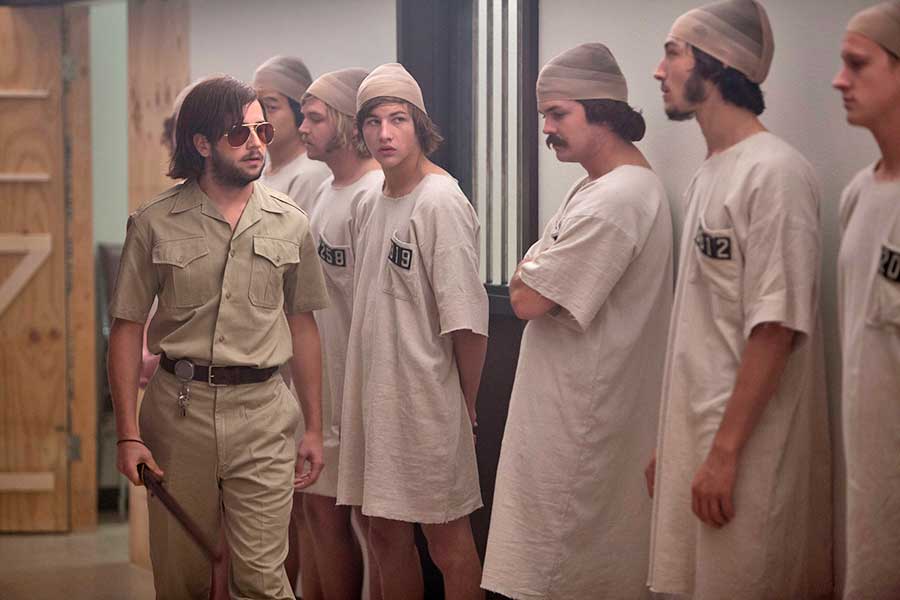“The Stanford Prison Experiment,” opening July 31 at Ritz Theaters, is gay filmmaker Kyle Patrick Alvarez’s take on Dr. Philip Zimbardo’s project conducted at the titular university in 1971. The study was designed to observe the effects of prison on human behavior. Twenty-four male students were divided into prisoner and guard roles in a mock jail. There were basic rules established to prevent physical abuse, but the guards were instructed to keep control over the prisoners. The experiment becomes overwhelming for the prisoners, who struggled and rebelled.
The story has been told before as “Das Experiment,” a 2001 German film, and “The Experiment,” an American remake in 2010. However, those previous versions were done in prison facilities. Alvarez sets his intense, tightly wound film in the hallways and offices of the Stanford psychology building, to increase the emotional and physical claustrophobia. The decision is effective as the director uses his camera to unflinchingly record the characters’ breakdowns and breakthroughs.
Alvarez spoke with PGN to discuss “The Stanford Prison Experiment.”
PGN: What prompted you to tell this story, which has been told before both in books and films?
KPA: I asked myself that a lot, actually. This script was well-written and taut. I went back and read the Wiki page on the story, and it wasn’t embellished. The [film’s] dialogue was created from transcripts and the staging was taken from the event. I was familiar with “Das Experiment,” but I didn’t want the other films in my head. They took it too far — people were dying, and they never showed the other side of the story. I felt the story was so important and compelling. We rebuilt the basement of Stanford down to the square inch. We presented the historical version, and that was gripping, so it deserves this take on it. Hopefully, it’s more relevant.
PGN: You are drawn to films that portray the complex male ego. “The Stanford Prison Experiment” also deals with that and the use and abuse of power. Can you comment on this theme that runs through your work?
KPA: I’ve made three films exclusively about men. It’s not my M.O.; I keep falling into them. It’s easy to hear the Stanford story and think they got drunk with power. I thought there is some truth to that, but there is a way to blur those lines a bit, and the final interviews are recreated nearly verbatim. They can look back and see themselves being abusive. The experiment is not about turning evil, but it is tied to the human condition, which is a lot frailer. Becoming these roles and role-playing is powerful, and we can get lost in that. It can happen to any of us. I tried to approach the story as a character drama. These kids were college-age, not adults. This film needs to be told this way to tap into the grayer areas and what institutions serve us, and how do we punish people.
PGN: Let me ask you a question that Zimbardo’s team asks the students: Have you ever given into an aggressive urge or impulse?
KPA: [Laughs] I don’t think I have. I’ve never thrown or taken a punch. I tend toward passivity at times. Maybe I shouldn’t. It’s easy to say I wouldn’t act like those guards. Making movies become potboilers in themselves, and pressures and anxieties boil up. Making this film, it was hard to keep the morale up.
PGN: The film is about the power of stripping away the individuality of the men, “feminize them” as one character says, to show how institutions affect individuals’ behavior. I see a parallel here to how gay men are sometimes treated. As a gay man, how did you approach this film?
KPA: In some ways, my other films were about homosexuality. Sexuality exists in gendered ways here — the woman saves the day. There was a heightened awareness about the role of homoeroticism at play in the experiment. What I thought was relevant was the sexual humiliation in the last night. When you take away everything from someone, sexual humiliation is all that’s left. It’s worse than physical humiliation. That’s what’s so upsetting. For me, it’s realizing that sexual humiliation is a subhuman state. My gay sensibility — being bullied as a kid — might have given me a heightened sensitivity. This film wasn’t as intensely personal as the other films I’ve made, though.
PGN: Yet, there is a clinical, detached approach you take to telling the story.
KPA: Yes. Even aesthetically, I thought, How are we going to shoot people watching the experiment? There are no close-ups until a character has a bag pulled off his head. There are no handheld shots until a character flips out, so there are no subjective shots. And that’s how I wanted to feel about the film. I didn’t want it to be didactic: You’re supposed to feel this.

